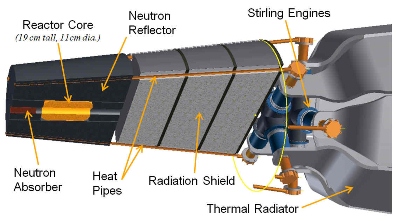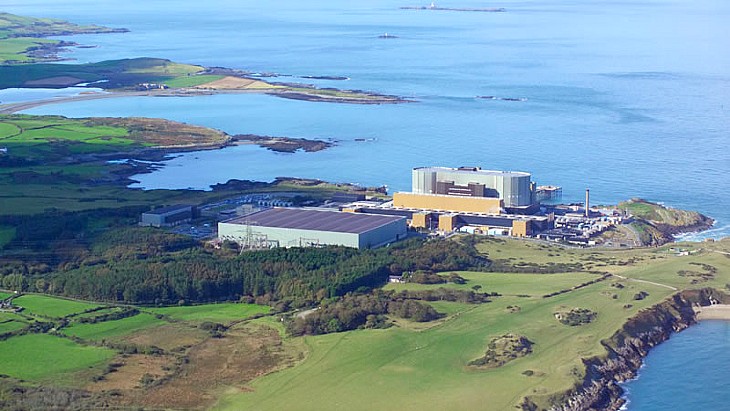A team of researchers from NASA and Los Alamos National Laboratory have demonstrated a new reactor concept that combines a Stirling engine with modern heat pipe cooling technology to provide a power source for future space missions.
 |
| LANL's new reactor concept (Image: LANL) |
The design is a remarkably simple combination of old and modern technology that is flexible, lightweight and does not require complex controls. According to the developers it could be used on exploration missions to supplement existing Pu-238 power systems, and therefore help preserve stocks of the valuable radioisotope, which is currently in short supply.
A full-scale reactor would consists of just six sections: a 23 kg enriched uranium core, a core reflector, a single control rod fully capable of turning the reactor on and off, radiation shielding and eight heat pipes connected to eight Stirling engines that would generate electricity. The entire unit would be compact and passively safe - relying on principles of nuclear physics to adjust reactivity and power output rather than any additional equipment.
Technology old and new
The Stirling engine was originally designed in the 19th century but only now with improved efficiency is it finding small niche applications. It is a simple closed loop design which contains a cylinder of pressurized gas that expands as it heats up and contracts as it does work. This can be used to generate electricity on a small scale, although it is not suitable for power stations. Requiring neither pumps or fans, heat pipes are a form of passive cooling technology now commonly included in laptops and other electronics. They consist of a sealed tube containing an internal liquid which circulates to transport heat. They were invented in Los Alamos in 1963.
Being modular with an intended capacity of 500 We, it would be straightforward to add units as required and future scaled-up designs could even be used for both surface and space propulsion. The simplicity of the design makes it easy to assemble and should make it comparatively easy to license.
The Demonstration Using Flattop Fission (DUFF) experiment was carried out at the Nevada National Security Site’s Device Assembly Facility. The scaled-down prototype - dubbed KRUSTY (Kilowatt Reactor Using Stirling TechnologY) -produced only 24 We, but confirmed the basic principle of the design. "The nuclear characteristics and thermal power level of the experiment are remarkably similar to our space reactor flight concept," noted Los Alamos engineer David Poston. "The biggest difference between DUFF and a possible flight system is that the Stirling input temperature would need to be hotter to attain the required efficiency and power output needed for space missions."
DUFF is noteworthy in being the first demonstration of a new space reactor system to take place in the USA since 1965. Its designers hope that it will open up "new frontiers" for space exploration and research. The demonstration arguably also holds lessons for the verification and testing of new nuclear power reactors. "Perhaps one of the more important aspects of this experiment is that it was taken from concept to completion in 6 months for less than a million dollars," said Los Alamos engineer David Dixon. "We wanted to show that with a tightly-knit and focused team, it is possible to successfully perform practical reactor testing."
Researched and written
by World Nuclear News




_50545.jpg)
_40405.jpg)

_45542.jpg)
_76087_55556.jpg)




